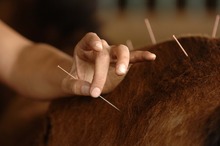According to Ben Baugh, staff writer for the Aiken Standard, the use of accupuncture and chiropractic treatment have been successful in returning a horse to full health and a normal level of activity.

Successful use of accupuncture in horse
In a case of a horse lacking in energy and revealing muscle soreness, accupuncture and chiropractic treatment are successful in restoring the horse to a normal level of activity.
© 2012 by Carienne Schippers
When Janet Nagar's Fhantom, an 11-year-old Hanoverian gelding, trained as a dressage horse was lacking in energy and appeared to be sore from head to tail, she called Golden Rule Equine Services to have Dr. Stephanie Simonson identify and address the issues that were the source of Fhantom's problem.
"He was presented to me as lacking in energy with asymmetrical muscling and very tight muscling in his right hind," said Dr. Simonson.
When the veterinarian wanted to see Fhantom move, the gelding was very reluctant to do so, and when he did, it was as if he were walking on egg shells. Fhantom appeared to be hurting all over.
As a veterinarian, Simonson looks at the whole horse, and not just in ways where she would apply the modalities of acupuncture and chiropractic to help the horse improve.
"Janet had talked about injecting the hocks," said Simonson. "She wanted me to look at Fhantom before she did that."
It was while the two were talking that Nagar informed Simonson that Fhantom has Equine Polysaccharide Myopathy, or Polysaccharide Storage Myopathy, a glycogen storage disease, where the horse accumulates abnormal amounts of glycogen in the muscles and abnormal levels of polysaccharide in the skeletal tissue.
Equine polysaccharide storage myopathy (EPSM) is a form of rhabdomyolysis classified as a metabolic disease that results in the accumulation of high muscle glycogen and abnormal polysaccharide in skeletal muscles.
Horses that are affected generally are referred to as having a calm demeanor and being heavily muscled. Signs often occur 10-20 minutes after light work in 2-4 year olds starting training, but signs can also occur at any stage of life. The episodes may occur once or twice a year to every time the horse is exercised. A common complaint is that horses are exercise intolerant, especially at high speeds.
Fhantom was presenting like a PSSM horse, with his reluctance to move, muscle fasciculations, asymmetrical muscling, reluctance to back, a tucked up abdomen and was not willing to hold weight for the farrier.
Simonson thoroughly examined Fhantom, scanning him through her acupuncture channels, and she also looked at the Hanoverian gelding's feet, which played an important role in her diagnosis.
"His feet were very unbalanced," said Simonson. "My first thought was that he was foot sore, so we had to address that, but on further examination, he was sore on both sides of his back. I wanted to look at the saddle. I also had to be cognizant of the PSSM because you can have muscle damage from that."
Simonson had to weigh whether Fhantom was ready for an acupuncture treatment because of the muscle tightness and fasciculations.
"My goal that day was to get him comfortable and to see if he was going to improve in order to make further diagnostic changes like injecting hocks or further treating the PSSM," said Simonson. "Janet seemed to have it controlled up to that point and actually has since that time. He has a great attitude, is very opinionated, and that helps a lot."
Fhantom began showing signs of improving after receiving his first chiropractic adjustment, where a great deal of emphasis was placed on muscling adjustment.
"We were really thrilled about that," said Simonson. "Janet was really diligent. I came out every two weeks for a while. I was able to put some acupuncture needles in him and addressed the PSSM as well as muscle soreness, trying to boost his immune system."
The Hanoverian gelding began to show signs of progressive improvement. PSSM can also be controlled with nutrition, said Simonson.
"Janet checked his saddle, got a different farrier, and basically, to this day, is riding him," said Simonson. "He's in training, and he's doing really well."
